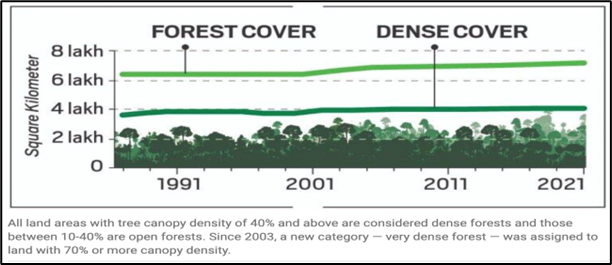What’s in today’s article?
- Background (Context, FSI’s Report, How is Data computed, etc.)
- Forest Land Encroachment (Meaning, Causes, Loss of Old Forests, Suggestions, etc.)
Background:
- India is one of the few countries to have a scientific system of periodic forest cover assessment in the form of India State of Forest Report.
- India State of Forest Report is an assessment of India’s forest and tree cover.
- It is published every two years by the Forest Survey of India (FSI) under the Ministry of Environment, Forests and Climate Change.
- The first survey was published in 1987.
How is data computed for the Report?
- Data is computed through wall-to-wall mapping of India’s forest cover through remote sensing satellites.
- Three categories of forests are surveyed –
- Very Dense Forests (canopy density over 70%),
- Moderately Dense Forests (40-70%) and Open Forests (10-40%),
- Scrubs (canopy density less than 10%)
- Forest Cover is defined as –
- “An area more than 1 ha in extent and having tree canopy density of 10 percent and above”.
- Tree Cover is defined as –
- “Tree patches outside recorded forest areas exclusive of forest cover and less than the minimum mappable area of one hectare”.

- The data is used in planning and formulation of policies in forest management as well as forestry and agroforestry sectors.
- Since 19.53% in the early 1980s, India’s forest cover has increased to 21.71% in 2021.
- Adding to this a notional 2.91% tree cover estimated in 2021, the country’s total green cover now stands at 24.62%, on paper.
Forest Land Encroachment:
- Encroachment is a term used to describe the advancement of structures, roads, railroads, improved paths, utilities, and other development, into natural areas.
- The National Remote Sensing Agency (NRSA) under the Department of Space estimated India’s forest cover using satellite imagery for periods 1971-1975 and 1980-1982 to report a loss of 2.79%. It declined from 16.89% to 14.10% — in just seven years.
- While reliable data on encroachment is unavailable, government records show that 42,380 sq km — nearly the size of Haryana— of forest land was diverted for non-forest use between 1951 and 1980.
Loss of Old Forests:
- In India, land recorded as forest in revenue records or proclaimed as forest under a forest law is described as Recorded Forest Area.
- Over time, some of these Recorded Forest Areas lost forest cover due to encroachment, diversion, forest fire etc.
- Meanwhile, tree cover improved in many places outside the Recorded Forest Areas due to agro-forestry, orchards etc.
- In 2011, when the FSI furnished data on India’s forest cover inside and outside Recorded Forest Areas, it came to light that nearly one-third of Recorded Forest Areas had no forest at all.
- In other words, almost one-third of India’s old natural forests — over 2.44 lakh sq. km (larger than Uttar Pradesh) or 7.43% of India — were already gone.
Shrinking of Natural Forests:
- Even after extensive plantation by the forest department since the 1990s, dense forests within Recorded Forest Areas added up to cover only 9.96% of India in 2021.
- This loss remains invisible due to the inclusion of commercial plantations, orchards, village homesteads, urban housings etc as dense forests outside Recorded Forest Areas.
- The steady replacement of natural forests with plantations are worrisome for the following reasons –
- First, natural forests have evolved naturally to be diverse and, therefore, support a lot more biodiversity.
- Secondly, plantation forests have trees of the same age, are more susceptible to fire, pests and epidemics, and often act as a barrier to natural forest regeneration.
- Thirdly, natural forests are old and therefore stock a lot more carbon in their body and in the soil.
How to Expand India’s Forest Cover?
- As mentioned earlier, India’s forest cover has increased to 21.71% in 2021.
- Soon after its independence from Britain in 1947, India came out with its first national forest policy in 1952, which had a target of bringing 33 percent of India's land under forest coverand since then, the target has remained as it is.
- In the present scenario, the possibility of a sizeable increase in forest cover is limited due to the inelasticity of forest land.
- However, the balance of 9 percent can be achieved through taking up plantation/afforestation outside the forests and restocking/plantation in degraded and scrub forests.
- This can be done by –
- Substantially increasing the tree cover outside forests by incentivising and promoting agro-forestry and farm forestry;
- Managing and expanding green spaces in urban and peri-urban areas to enhance citizens’ well-being;
- Plantation of trees outside forests in partnership with local communities, land-owning agencies, and private enterprises;
- Creation, sustainable management and promotion of urban forests (woodlands, gardens, avenue plantations, herbal gardens, etc.) as an integral component of urban habitat planning and development;
- Afforestation/reforestation in public-private partnership (PPP) mode;
- Promotion of urban forests, which include woodlands, wetlands, parks, tree groves, tree garden, plantations in institutional areas, on avenues and around water bodies, etc.










